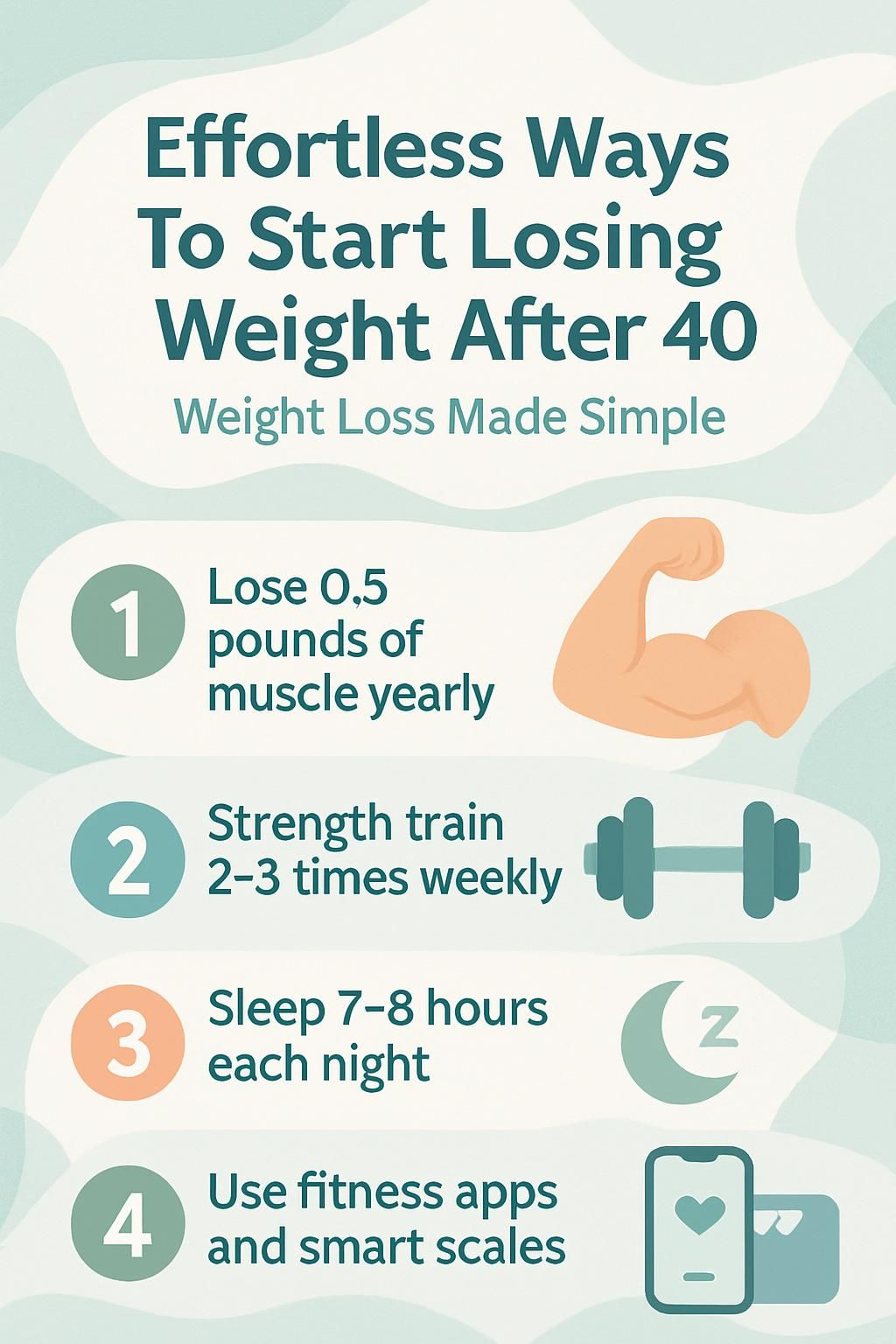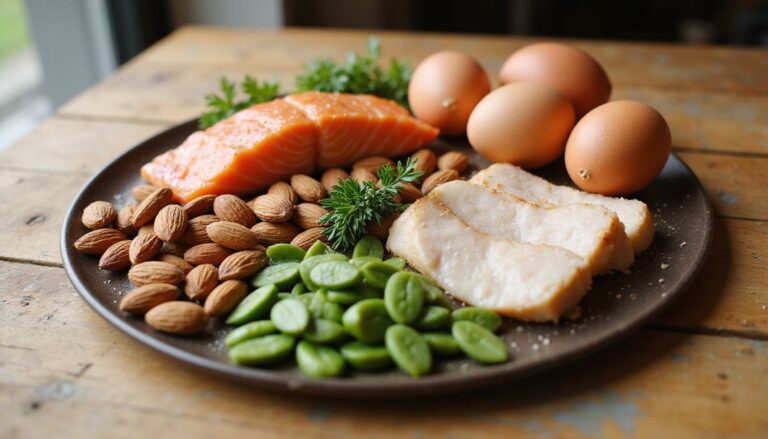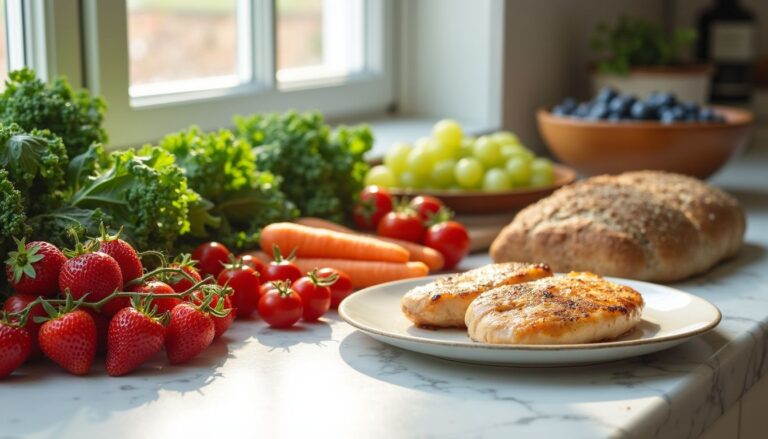Effortless Ways To Start Losing Weight After 40 – Weight Loss Made Simple
Our Nutrition Assistant AI Suite will transform your body. You will lose fat, get toned, and build muscle. Gain confidence and optimal health.
It can feel harder to lose weight after 40, even with years of diet and exercise. Metabolism and hormones shift in midlife, which can change where fat sits and how fast you burn calories.
This guide breaks weight loss into simple steps you can start today. You will learn how strength training, smarter eating, better sleep, and stress control work together to help you reach a healthy weight.
Key Takeaways
- After 40, adults can lose about 0.5 pounds of muscle each year. Less muscle lowers metabolism and raises the risk of weight gain around the abdomen.
- Do strength training two to three days per week. Pair it with high-intensity interval training, called HIIT, to protect muscle and burn more calories.
- Eat more protein, fiber, and whole, unprocessed foods, and cut refined sugar and white flour. This supports hunger control and lowers insulin resistance.
- Get seven to eight hours of sleep and manage stress with methods like meditation or yoga. Lower cortisol means fewer cravings and less belly fat storage.
- Use fitness apps, smart scales, and wearables to track food, activity, and body composition. Tracking builds accountability and supports long-term weight management after 40.

Why Is Losing Weight After 40 More Difficult?

Midlife brings changes that slow calorie burn and shift body composition. Think of it as your body changing gears, not hitting the brakes.
How Does Metabolism Slow Down After 40?
Starting in your 30s, your body can lose about 0.5 pounds of muscle each year. Muscle burns more calories than fat, even when you rest. With less muscle, basal metabolic rate, which is the energy you burn at rest, declines.
If you keep eating the same amount, weight gain often follows. Crash diets can speed up muscle loss, which slows metabolism even more. Age can also raise insulin resistance, making it easier to store fat around the belly.
As a personal trainer, I have seen clients skip strength work and then struggle to keep weight off. Adding resistance training helped them maintain muscle and improve results.
What Hormonal Changes Affect Weight Loss After 40?
Estrogen and testosterone decline with age. During menopause, estrogen falls more sharply. Lower estrogen can change fat storage and raise the chance of gaining several pounds, according to the U.S. Office on Women’s Health.
Men often see lower testosterone in midlife. Less testosterone can reduce muscle and increase body fat. Appetite hormones also shift. Leptin signals fullness and ghrelin signals hunger; changes in both can spark cravings.
Higher stress raises cortisol, a hormone that encourages fat storage around the stomach. Poor sleep and hot flashes can make healthy routines harder to follow.
Hormonal changes in midlife shift where you gain weight, leading many people over forty to notice extra belly fat.
Support your body with a balanced diet rich in protein and fiber, regular aerobic exercise like brisk walking or swimming, and consistent stress management. Guidance from agencies such as the Centers for Disease Control and Prevention supports these steps.
Why Does Muscle Mass Decrease With Age?
Hormones influence muscle loss, and daily habits do too. After 30, skeletal muscle, which is the muscle that moves your body, can decline each year.
Women may lose about 0.5 pounds of muscle yearly after 30, and men face a similar drop by their 40s. Less movement speeds up this loss. Crash diets remove both fat and muscle, which can hurt strength and metabolism.
I once tried a strict low-calorie plan without lifting weights. My strength fell fast. Rebuilding took time, and my metabolism felt slower until I added resistance training back in.
Effortless Ways To Start Losing Weight After 40
Small changes add up. Start with a few habits you can repeat most days, then build from there.
How Can Strength Training Help Build Muscle?
Strength training makes your muscle fibers stronger and thicker. This helps you burn more calories and shapes a healthy body as you age.
Use dumbbells, resistance bands, kettlebells, or machines. Cover five patterns each week: push, pull, squat, hinge, and loaded carry. Pick one move for each pattern and do about 10 reps at a comfortable weight.
Train two to three days per week. For heavy lifts, try up to five sets of two reps. For lighter weights, try two sets of five reps. Mix bilateral lifts like squats with unilateral moves like lunges.
Combine strength work with HIIT for extra calorie burn and better weight control.
Building muscle through strength training supports both fat loss and bone health as you age.
When I added two weekly lifting sessions to my walking routine, my clothes fit better within months. The scale barely moved, but my shape and energy improved.
What Is High-Intensity Interval Training (HIIT) and How Does It Help?
HIIT uses short bursts of hard effort with easy recovery periods. For example, run for 15 seconds, then walk for 45 seconds. Repeat for 20 minutes.
Research shows HIIT can improve weight loss, blood sugar control, and blood pressure. Choose activities you enjoy like walking, cycling, or swimming so you stay consistent.
Start at a level that feels safe, then raise intensity little by little. Vary your routine to keep it fresh. Pair HIIT with strength training to protect muscle after 40 and support your weight loss goals.
Why Should You Eat More Protein After 40?
Muscle naturally declines with age. Protein helps protect it while you work toward a healthy weight. Good options include eggs, fish, poultry, beans, and low-fat dairy.
Experts suggest a balance of protein, complex carbohydrates, and healthy fats at each meal. In a National Institutes of Health study, adults who increased daily protein kept more muscle during weight loss.
I stayed full longer after adding chicken and yogurt to my meals. That cut my snacking and helped me control calories without feeling deprived.
Choose varied protein sources for vitamins and minerals. Enough protein also makes your workouts more effective and supports steady energy through midlife changes.
How Do Whole, Unprocessed Foods Support Weight Loss?
Whole foods help manage insulin resistance, which often rises with age. Build meals around vegetables, fruits, lean proteins, and healthy fats like olive oil or nuts.
Keep carbohydrates, but favor low glycemic options such as whole grains and legumes instead of candy or pastries. These choices reduce spikes in blood sugar and keep you fuller longer.
Preparing simple meals at home gives you more control over portions and ingredients. That can reduce cravings for ultra-processed snacks and support steady weight loss.
How Can Reducing Sugar and Refined Carbs Help Weight Loss?
Cutting sugary foods and refined grains supports better blood sugar control and weight loss. Items like candy, cookies, and white bread digest quickly and can spike insulin, which is a hormone that helps your body use sugar.
A Diabetes Care study linked lower sugar intake to weight loss and improved cholesterol in adults over 40. Try whole grains, beans, and non-starchy vegetables for longer-lasting fullness.
During a low-carbohydrate phase last year, I had fewer cravings and more steady energy. National nutrition survey data also suggests that lower refined carbs can support a healthier body weight.
Why Is Increasing Fiber Important for Weight Loss?
Fiber helps you feel full on fewer calories. It also slows the rise of blood sugar, which can curb hunger and cravings.
Choose vegetables, fruits, beans, and whole grains. These foods support heart health and help address insulin resistance that often grows with age.
I swapped white rice and bread for brown rice and whole-grain toast. Staying full between meals got much easier. High-fiber foods can also support healthy blood pressure and cholesterol, which matter more as you age.
How Does Staying Hydrated Affect Weight Loss?
Water supports your metabolism and can help reduce hunger. Research shows that drinking about 16 ounces of water before meals can lower calorie intake.
Hydration can reduce cravings that are really thirst in disguise. It also supports physical activity by improving energy.
Track water along with food in a mobile app if that helps you stay consistent. A simple check is urine color. Aim for pale yellow most of the day.
What Role Does Sleep Play in Weight Loss and Recovery?
Sleep affects appetite hormones and calorie burn. Adults over 40 often report sleep problems, especially during and after menopause. NIH reports suggest that 35 to 60 percent of women in midlife have sleep issues.
Poor sleep is linked with higher body weight. In one study, 35.5 percent of men sleeping under seven hours had obesity levels of BMI 30 or higher. Only 26.5 percent did when they slept at least seven hours.
Aim for seven to eight hours most nights. Better sleep supports appetite control, muscle recovery, and immune health. Short nights can raise cravings and slow results, even with a good diet and exercise plan.
How Can Managing Stress Improve Weight Loss Results?
Stress raises cortisol, which pushes the body to store more belly fat. It can also trigger cravings for sugary or salty foods.
Use deep breathing, meditation, yoga, outdoor walks, or other relaxation techniques. Studies show that stress management can lower cortisol and improve mood.
Lower stress after 40 makes it easier to follow your plan and limits waistline fat that often comes with hormonal changes. Small daily tools can protect your progress and your mindset.
Simple Lifestyle Adjustments for Long-Term Success
Daily routines shape results. A few simple tweaks can make healthy choices easier and more automatic.
How Does Using Smaller Plates Control Portions?
Smaller plates can nudge you to eat less without feeling deprived. A full plate looks satisfying to the brain, even if the portion is smaller.
Research suggests plate size can affect intake, which matters more once metabolism slows. MyPlate style portions are easier to follow with a smaller dish.
I switched to smaller plates last year and felt full sooner. Evening snacking dropped without any calorie counting.
What Are the Benefits of Eating Mindfully?
Mindful eating teaches you to notice hunger and fullness. Paying attention to flavor and texture helps you spot emotional eating and reduce distractions like screens at meals.
Studies show mindful eating can cut calorie intake and support steady weight loss. In a Harvard review, slower eaters were less likely to gain excess weight.
Eating slowly helped me feel satisfied with smaller portions. Meal planning fits well with mindfulness because it reduces last-minute choices.
Why Should You Plan Meals and Snacks Ahead?
Planning removes guesswork. You can build each meal with lean protein, complex carbs, and healthy fats for steady energy and better control of hunger.
Research shows meal planners often eat healthier foods and manage portions better. A 2020 American Journal of Preventive Medicine study found planners were 28 percent less likely to become overweight.
I prep on Sundays so weeknights feel easier. Healthy options are ready, which limits impulse choices from vending machines or drive-throughs.
Structured planning also supports very-low-calorie diets and post-bariatric guidelines that rely on consistent meal timing and portions.
How Can Limiting Late-Night Eating Support Weight Loss?
Late-night snacks often add extra calories and can disrupt sleep. As metabolism slows with age, those extra calories add up faster.
Many evening snacks are high in sugar or refined carbs, which can raise blood sugar and harm sleep. Poor sleep then increases cravings the next day.
Try herbal tea after dinner instead of dessert. Many people find daytime hunger improves once they stop eating late at night.
How Important Is Consistency in Daily Physical Activity?
Regular movement protects muscle, supports heart health, and helps manage stress. A routine of two to six workout days per week can prevent weight gain and slow muscle loss.
People over 40 who exercise consistently tend to keep a healthier weight than those who are inactive. Walking every day helped me keep energy up and stress down.
Consistency builds momentum. The more regular your routine, the easier habits become.
Tools and Resources to Support Weight Loss
Good tools make healthy choices simpler. Use them to track progress and stay motivated.
How Can Fitness Apps Help Track Calories and Exercise?
Apps make logging food and activity fast. Many include barcode scanners and saved meals so you can track without much effort.
Notifications can nudge you to move or log meals. Seeing your trends in charts can highlight what works and where to adjust.
Tracking meals helped me avoid mindless snacking late at night. Watching my weekly steps rise was motivating.
What Are the Benefits of Using Smart Scales?
Smart scales measure more than weight. Many models estimate body fat, muscle mass, and water content.
These numbers help you understand how muscle gain or fat loss is changing your body shape. Syncing with your phone makes trends easy to spot.
After forty, this feedback can guide your plan. Many people feel more accountable when they can see progress in multiple ways.
How Do Wearable Fitness Devices Support Weight Loss?
Wearables track steps, heart rate, and daily activity. Real-time feedback builds accountability and can nudge you to move more.
Alerts help you hit step goals by the end of the day. Graphs and weekly summaries show patterns tied to better results.
Setting small goals and adjusting based on device feedback can speed up habit building. Every active minute counts.
The Role of Nutrition in Weight Loss
Food is fuel for your plan. Balanced meals keep energy steady and support a healthy weight after 40.
How to Balance Macronutrients for Sustained Energy?
Include all three macronutrients at meals. Choose lean protein like chicken or tofu, complex carbs such as whole grains or sweet potatoes, and healthy fats from olive oil, nuts, or seeds.
A simple plate method works well. Fill half your plate with vegetables and fruit, one quarter with protein, and one quarter with whole grains or starchy vegetables.
Example: baked salmon with quinoa, a spinach salad, and sliced avocado. This pattern supports weight control and reduces blood sugar spikes.
Tracking meals helped me spot low-protein days. Adjusting portions reduced afternoon crashes and improved focus.
Why Include Healthy Fats for Feeling Full Longer?
Healthy fats digest slowly, which keeps you full longer and can prevent snacking. Sources include avocados, nuts, seeds, and olive oil.
Studies from the Harvard School of Public Health link unsaturated fats to better satiety and appetite control. Nuts as snacks have been shown to lower hunger in adults over 40.
Pair healthy fats with fiber-rich foods for stronger fullness. These fats also help your body use fat-soluble vitamins.
How Do More Fruits and Vegetables Aid Weight Loss?
Fruits and vegetables are high in water and fiber, so they fill you up with fewer calories. One cup of strawberries has about 49 calories and 3 grams of fiber.
Eating a variety of produce improves nutrient intake and supports overall health. Antioxidants like vitamin C protect your cells during weight loss.
I added spinach and berries to breakfast. That simple swap lowered my daily calories and boosted energy for morning walks.
Exercises That Support Weight Loss After 40
Exercise helps you burn calories and preserve muscle. Mix strength, cardio, and flexibility work for the best results.
How Does Strength Training With Weights or Bands Help?
Strength training increases lean muscle, which burns more calories at rest. Use dumbbells, bands, kettlebells, or machines.
Train two to three days per week. Alternate bilateral moves, like two-leg squats, with single-side moves, like one-arm presses. This approach helps engage more muscle.
Research shows consistent lifting supports weight control and protects bone health after 40. Using both dumbbells and bands kept my workouts fresh and results steady. HIIT pairs well with lifting for extra calorie burn.
What Are Low-Impact Cardio Exercises for Weight Loss?
Walking, cycling, swimming, and easy jogging are joint-friendly ways to burn calories. Choose activities you enjoy so you stick with them.
For beginners, try intervals. Run or pedal hard for 15 seconds, then go easy for 45 seconds. Repeat for about 20 minutes.
Low-impact cardio protects knees and hips while building endurance. My morning walks raised my energy within a few weeks. Yoga or Pilates can add flexibility and help manage stress.
Next, see how yoga and Pilates support your plan.
How Can Yoga and Pilates Improve Flexibility and Reduce Stress?
Yoga and Pilates use slow, controlled movements with focused breathing. This improves flexibility and can lower stress levels.
Research links yoga with lower stress hormones and better mood. Pilates improves posture and core control, which can reduce tension.
Two weeks of brief morning yoga eased my back stiffness. Deep breathing, a key element in both practices, can support stress control, which may aid weight loss.
Overcoming Common Weight Loss Challenges
Progress is rarely a straight line. Expect obstacles and use simple tools to keep moving forward.
How Can You Stay Motivated When Progress Is Slow?
Set small goals that you can achieve most days. Examples include a 20-minute walk or building meals from whole foods.
Track habits in a journal or app to see wins that the scale might miss. Treat long-term weight loss like a marathon. Celebrate actions, such as cooking a healthy dinner or finishing your workouts for the week.
Patience and consistency protect motivation when the scale pauses.
What Are Effective Ways to Overcome Weight Loss Plateaus?
Plateaus are common, especially after early success. Change your routine to spark new progress.
Try HIIT if you usually do steady cardio. Raise intensity as your fitness improves. The Centers for Disease Control and Prevention reports better results when adults increase workout challenge over time.
Review your diet for hidden sugars or refined carbs. Research from Harvard Health links lower refined carbs with more fat loss after 40. Increase protein to guard muscle, since muscle loss slows metabolism.
Simple strength moves at home like squats and push-ups helped me restart progress. Stay consistent with fiber and hydration so your metabolism keeps humming.
How Do You Manage Emotional Eating?
Use mindfulness, meditation, and yoga to reduce stress-driven snacking. The American Psychological Association reports that stress often leads to cravings for high-calorie foods.
Yoga can reduce cortisol, which may ease cravings. Meditation helps you tell the difference between stress and true hunger.
Keep a food and feelings journal. Note what you eat and how you feel before and after. If the urge to snack hits, take slow breaths or go for a short walk.
These simple steps can break the link between emotions and eating, which supports weight loss after 40.
Maintaining Weight Loss for the Long Term
Sustainable habits matter more than quick fixes. Build a plan you can live with, not just for a month.
How to Avoid Weight Cycling?
Avoid crash diets. Fast weight loss often removes muscle along with fat, which lowers metabolism and makes regain more likely.
Research shows many people who lose weight quickly gain it back within a year. Aim for one to two pounds per week. That pace fits real life and protects muscle.
Balanced meals, regular exercise, and realistic goals build a foundation for lasting change.
What Are Sustainable Habits for Food and Fitness?
Fuel with balance. Build meals with lean protein, complex carbs, and healthy fats to keep energy steady.
Follow CDC guidance of at least 150 minutes of moderate activity per week. That is about 30 minutes per day, five days a week. Track progress with apps or a smart scale.
Short walks after dinner and more standing time can raise daily movement. Choose water over sugary drinks and keep healthy snacks ready. Quality sleep helps your body recover and stay on track.
Small actions repeated often make weight loss maintenance feel doable after 40.
Why Celebrate Non-Scale Victories?
Focusing only on the scale can be discouraging. Notice wins like better sleep, higher energy, or new strength gains.
Clothes may fit better and daily tasks may feel easier even if weight changes slowly. These signs show your plan is working and support motivation.
People who track non-scale victories often stick with healthy routines longer. That leads to stronger long-term results.
Conclusion
Losing weight after 40 takes steady effort, not perfection. Build muscle with strength training, add short HIIT sessions, and focus on whole foods with more protein and fiber. Guard your sleep, manage stress, and plan meals so daily choices feel simple.
Set realistic goals you can repeat for months. Celebrate progress in how you feel, not just what the scale shows. If you have a medical condition or take medications, talk with your healthcare provider before changing your diet or exercise plan. Small steps done often can help you reach a healthy weight and keep it.
FAQs
1. What are some effortless ways to start losing weight after 40?
Simple changes help. Eat more vegetables and lean proteins. Reduce processed foods and sugary drinks. Walk daily or add light exercise, such as swimming or cycling. Studies show that adults over 40 who walk at least 30 minutes a day can improve weight loss outcomes (Harvard Health Publishing, 2022). These steps support steady progress.
2. Why does weight loss become harder after age 40?
Metabolism slows with age. Muscle mass decreases, which lowers calorie burn at rest. Hormonal changes also affect how the body stores fat. Research from the Mayo Clinic shows adults over 40 may need fewer calories than younger people to maintain weight. Adjusting food choices and activity levels helps address these changes.
3. How important is sleep for losing weight after 40?
Quality sleep is vital for weight control at any age but especially after 40. Poor sleep affects hormones that regulate hunger and fullness, leading to increased cravings for high-calorie foods (National Institutes of Health, 2021). Aim for seven to nine hours of sleep each night for better results.
4. Can small lifestyle changes make a real difference in weight loss for those over 40?
Yes, small changes matter. Swapping soda for water, eating smaller portions, and adding short walks throughout the day all contribute to gradual weight loss. Personal experience shows that tracking meals for one week helped identify hidden sources of extra calories, making it easier to adjust habits for lasting results.
Summary: Weight loss after 40 is possible with simple diet changes, regular movement, enough sleep, and small lifestyle adjustments supported by research and personal experience.







